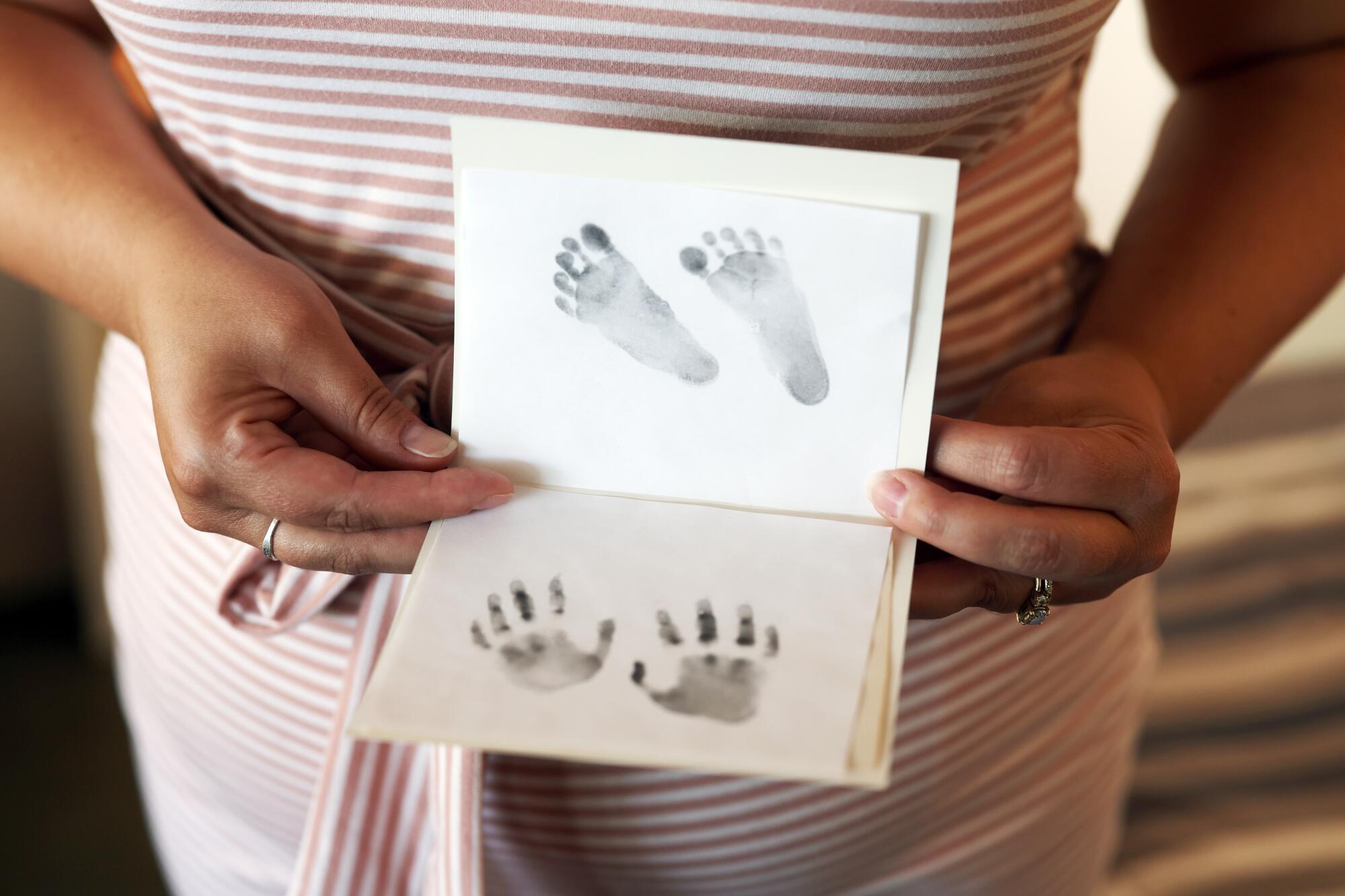
Jeni and her husband had already put together their baby nursery and drafted a list of names when she learned the baby she had been carrying for 33 weeks had a brain that had not developed properly.
A year later, Christina and her husband faced a similar diagnosis for their child at 28 weeks of gestation: excess fluid had built up in the skull, preventing the brain from growing correctly.
The two California women, both in their mid-30s, didn’t know each other but faced the same agonizing days between initial diagnosis and final confirmation of what’s called ventriculomegaly. Though no doctor could tell them exactly what their child might endure, they faced a spectrum of scenarios: death in utero, developmental delays, a short, seizure-filled life in the neonatal ICU.
Jeni and Christina, who didn’t want their last names used for privacy reasons, made the decision that neither ever fathomed they would make: ending a wanted pregnancy in the third trimester.

Already grieving their losses, Christina and Jeni soon faced a second blow: It is illegal to perform an abortion in California after a fetus is viable, unless the patient’s life or health is at risk.
Their ability to obtain an abortion in California would hinge on whether doctors believed their fetus met the legal definition of “viable” — able to live outside the womb without intensive medical intervention. If a fetus was deemed viable, they would have to leave California to get the abortion.
But in a demonstration of how access can change depending on geography, individual doctors and interpretation of the law, this is where their stories diverged. One woman would be able to get the procedure in California; the other would find herself on a plane to Colorado for an abortion that would cost $17,000, plus travel expenses.
::
As red states move to prohibit abortion after the U.S. Supreme Court’s reversal of the Roe vs. Wade decision in June, California’s political leaders have heralded a different path.
Gov. Gavin Newsom and other Democrats have called California a haven or sanctuary for residents of other states who need an abortion. The state has announced a $200-million boost for reproductive health services, eliminated out-of-pocket costs for abortion and enacted a bill to protect California’s health providers from being sued by states that ban the procedure.
“We live in California, we live in one of the most progressive states. Why would this be an issue?”
— Christina, on having to leave the state for a late-term abortion
Compared with the rest of the country, California has some of the nation’s most progressive abortion policies, including state-funded coverage of abortion in Medi-Cal. In fact, California is the only state the Guttmacher Institute, a research group that supports abortion rights, lists as “very supportive” of those rights.
But for the patients who have needed an abortion later in pregnancy, the California abortion sanctuary leaves them behind.
“It’s frustrating,” Christina said. She acknowledges that when most people — even those who support reproductive rights — think about access, they don’t think of abortions in the third trimester because they’re so rare. Still, she never thought she’d have trouble accessing one in her home state.
“We live in California, we live in one of the most progressive states,” she recalls thinking when told she might not be able to get an abortion in the state. “Why would this be an issue?”
“The talking points are great if California were truly an abortion sanctuary,” Jeni said. “Even California has such a far way to go before we can call it a sanctuary or safe haven.”
No official statistics are kept on California residents who leave the state for an abortion. Katrina Kimport, a qualitative medical sociologist at UC San Francisco’s Advancing New Standards in Reproductive Health, says a conservative estimate is 100 Californians a year. It is probably an undercount, she said.
Kimport based that on her own research as well as numbers from Access Reproductive Justice, a California organization that helps patients with financial and logistical support to get abortions.
The group counted 122 first-time callers last year who were more than 24 weeks into pregnancy — the shorthand definition of viability for many providers — and seeking an abortion. Ultimately, 91 of them left the state for the procedure.
Though abortions after 24 weeks are exceedingly rare — fewer than 1% of them happen after 21 weeks, according to the federal Centers for Disease Control and Prevention — they draw the most visceral reaction when discussing the already complicated subject of pregnancy termination. They are the least understood, the most politically controversial and often exceedingly heartbreaking for the parents who pursue them. They are also the most expensive and the most medically complex.
Experts who have studied these abortions say they often take place either because the patient learned new information — perhaps a distressing medical diagnosis or something in their personal lives — or faced barriers to access that pushed the procedure deep into pregnancy. The latter category can include particularly young people and victims of rape or incest who might not know they’re pregnant for months or include low-income people who experience delays in getting treatment.
The Supreme Court’s decision in Dobbs vs. Jackson Women’s Health Organization, which has essentially eliminated abortion access in nine states already, could push more patients’ abortions later into pregnancy because of widespread clinic closures and the time needed for travel, taking off work or child care.
::

Christina was recently married and enjoying a relatively smooth pregnancy last year until she had a major ultrasound at 22 weeks, typically the happy time when parents can learn their child’s sex and see the first glimpses of the shape of the baby’s nose.
The sonographer, measuring the fetus to check for proper growth, found the brain cavity was slightly enlarged. Christina was told it probably wasn’t anything to worry about, but they would do more scans in the future to keep an eye on it.
As soon as four weeks later, the problematic growth had increased significantly and was now raising red flags. Christina was advised to get a fetal MRI. By the time that was performed a week later, she was in her 27th week.
She learned her child had severe ventriculomegaly, meaning excess fluid was rapidly building up in the skull, putting pressure on the brain and not allowing it to develop.
Christina feared her child was suffering in utero and, if she made it to birth, would face a painful, short life. “It would just be immediate hospitals for three months or six months — it would be pain and surgeries,” she said.
“In reality, there’s a lot of clinics and hospital systems that have this artificial 24-week cutoff which is both a superficial look at the law, as well as settling the comfort level of all the providers involved.”
— Dr. Mitchell D. Creinin, a UC Davis obstetrician-gynecologist
Ending the pregnancy, she reasoned, was the only recourse — “the right thing to do for my baby, not for me. There was never a question that that’s not what that child deserved.”
At 28 weeks of pregnancy, she informed her genetic counselor of her decision. The counselor’s response shocked her: Since she was past 24 weeks and her life was not at risk, it was probably too late to get the abortion in California. “If I was going to die, I think they would have done it,” Christina mused.
Christina briefly considered trying to find a physician in California to perform the procedure, but the genetic counselor’s comments discouraged her. Though leaving California would take her out of network and dramatically drive up the cost, weeks were slipping by and she had little choice.
There are 11 clinics in the United States that will go beyond 24 weeks and only six of them go beyond 26 weeks, according to Access Reproductive Justice. Six states and the District of Columbia do not have a gestational limit on when abortion is legal.
Christina ended up flying to a clinic in Boulder, Colo.
::
California’s abortion law, in effect since 2003 and designed to mirror Supreme Court precedent, says abortion is prohibited after viability has been established, unless life or health is at stake.
The definition of viability, however, is vague. The law leaves it up to a doctor’s “good faith medical judgment” to determine the “reasonable likelihood of the fetus’ sustained survival outside the uterus without the application of extraordinary medical measures.”
In practice, viability is often shorthanded to 24 weeks of gestation, and some doctors won’t even consider a case after that time.
Others, including Dr. Mitchell D. Creinin, a UC Davis obstetrician-gynecologist, say viability is more nuanced than a blanket 24-week ban and needs to be analyzed on a case-by-case basis, pointing to the fact that any baby born at 24 weeks gestation needs “extraordinary medical measures” to have any chance at survival.
“In reality, there’s a lot of clinics and hospital systems that have this artificial 24-week cutoff which is both a superficial look at the law, as well as settling the comfort level of all the providers involved,” Creinin said.
Hospitals considering whether to take cases typically bring them before boards of their specialists and lawyers. Patients are not included. For physicians, such cases pose ethically complex questions: Would a baby with a severe diagnosis, such as an unformed brain, truly be viable?
What’s more, the viability definition focuses on whether life is possible, not the quality of that life.
Creinin compares the issue with end-of-life care decisions. “Do I think my loved one’s going to come out of whatever’s going on and have a quality of life that I feel that person would want? It’s the same thing on the early end,” he said.
The question of viability has not been a major factor in recent policy debates over abortion.
Last year, with the Dobbs case looming, more than 40 organizations formed the California Future of Abortion Council to recommend a lengthy list of policy proposals “supporting equitable and affordable access to abortion care for Californians and all who seek care here.”
State legislative leaders took up a portion of the council’s recommendations this year and, notably, pushed through a proposed constitutional amendment that will go before voters in November. It would preserve the right to have an abortion in California, but would not change the current law on viability.
Even if the state were to lift the viability threshold, it would not immediately improve access, Creinin said, pointing to shortages in the teams of people needed to care for patients undergoing abortions later in pregnancy.
::
As with Christina, the first sign of trouble in Jeni’s pregnancy emerged during an ultrasound, this one at 20 weeks.
She and her spouse were told that one of the brain ventricles, cavities that store cerebrospinal fluid, was slightly enlarged and that it could be a sign their baby could face mild developmental delays.
But their doctor told them not to worry and they continued setting up the nursery and making other preparations at their Bay Area home. Uneventful ultrasounds followed until the 33rd week. By then, the spring of 2020, the COVID-19 pandemic was raging and partners weren’t allowed into the appointments.
Jeni went in alone but was quickly advised to call her husband on FaceTime.
The baby’s situation had grown much more dire. In addition to the ventriculomegaly, the baby’s head had grown to the 97th percentile but the body was much smaller. The corpus callosum— which connects the left and right sides of the brain — had not formed.
“There’s just no way to say goodbye to your baby. You’ve never met the baby, but it’s been with you this whole time. And you’re literally going into the clinic to stop his heart. It’s just so hard.”
— Jeni, whose baby’s situation had grown much more dire
Her physician “didn’t really even give us the option of performing the abortion,” Jeni recalled, but with problems mounting, she trusted a gut instinct that “we were on the bad side of bad.” An abortion, she decided, was the best choice for her and her baby.
Jeni, too, was told she’d have a hard time finding care in California and was referred to the Boulder clinic Christina would use.
Ultimately, she found a Beverly Hills-area physician who agreed to perform the first portion of the abortion — the injection that stops the heart. But that physician couldn’t do the rest of the procedure — delivery — because the baby was breach, a more complicated situation. Abortions after 24 weeks are already complex — they typically require inducement of labor — so they usually must be done in hospitals and require a team of doctors and nurses.
Jeni had to fly back to the Bay Area for a caesarean section that would take place the following day.
She is mindful that she had the financial resources to obtain the procedure — a privilege not afforded to every patient.
She and other women with financial means will probably always be able to travel to find treatment — whether it is from the parts of California that don’t have abortion clinics or from a red state that has banned the procedure or even from the United States entirely.
“But that’s not true for most of the country,” she said.
::
The night before the first part of the abortion, Jeni and her husband had driven to Malibu, a peaceful setting to contemplate what was to happen and to find a way to say goodbye.
“There’s just no way to say goodbye to your baby,” she said. “You’ve never met the baby, but it’s been with you this whole time. And you’re literally going into the clinic to stop his heart. It’s just so hard.”
While undergoing the C-section, Jeni was initially given light anesthesia that kept her fully conscious. She grabbed the nurse’s hands and asked for more meds, begging to not be aware of her surroundings.
When she woke up, it was over — but her parenting responsibilities were not. She’d have to complete paperwork and choose a name. She and her husband reached for the shortlist of names they had prepared.
“It became a list of names that we had to give to basically the records department to put on the death certificate,” Jeni said. “And you’re just forced to pick a name.”
More to Read
Sign up for Essential California
The most important California stories and recommendations in your inbox every morning.
You may occasionally receive promotional content from the Los Angeles Times.











